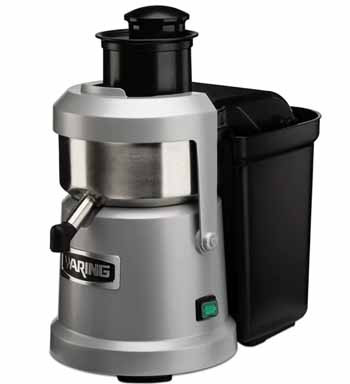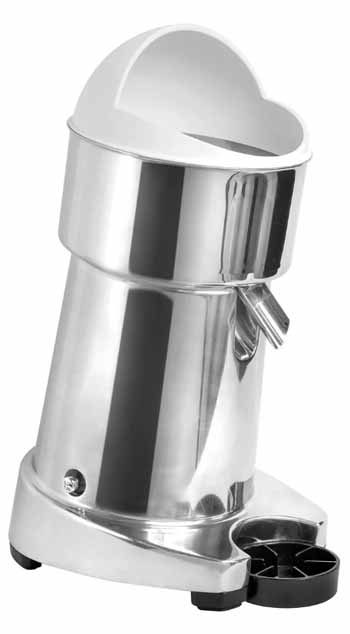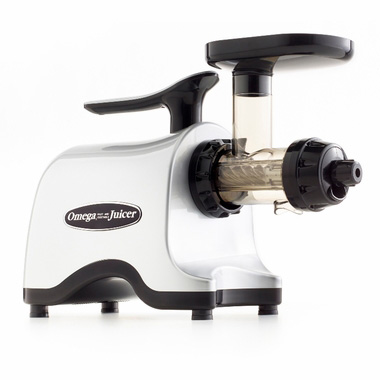With the growing demand for healthy beverages, opening a juice bar can be a profitable and fulfilling business. To open a juice bar or a storefront that serves fresh-squeezed juices and smoothies, you’ll need to plan carefully—from selecting your business model and location to creating a menu that appeals to your target customers.
Beyond crafting delicious and nutritious drinks, you’ll also need to consider budgeting, sourcing high-quality ingredients, purchasing equipment, and marketing your brand effectively.
Quick Stats:
- Startup costs: $100,000–$300,000 (storefront), $20,000–$80,000 (mobile/kiosk)
- Time to launch: 2–6 months
- Typical net profit margin: 10–50%
- Peak seasons: Summer months (30–40% of annual sales)
Step 1: Research the Juice Bar Industry
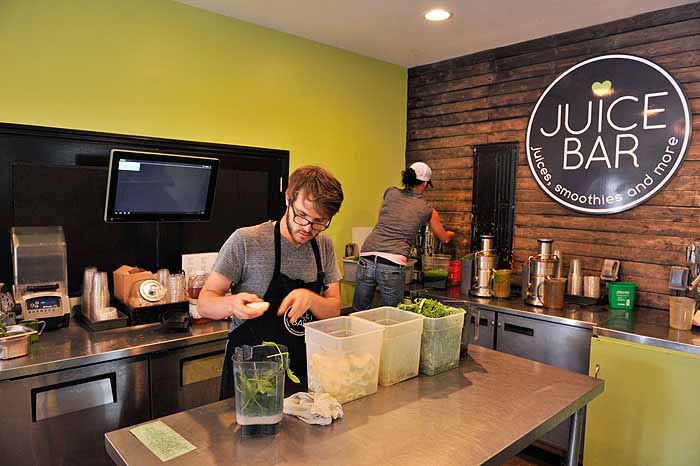
A look at the kitchen of Juice Bar in Huntsville, Alabama. (Source: Huntsville/Madison County Convention & Visitors Bureau)
Before opening your own juice bar, it’s important to understand how the industry operates. Juice bars serve a variety of fresh beverages, including cold-pressed juices, smoothies, and protein shakes, often with simple food items like salads and sandwiches. To get a real feel for the business, consider working at a juice bar to learn how drinks are made and see the daily operations firsthand.
If that’s not an option, thorough market research is key. Study successful juice bars in your area—look at their menus, busiest hours, pricing strategies, and marketing efforts. Understanding what works (and what doesn’t) will help you make smart business decisions and set your juice bar up for success.
Trends & Profitability
The juice and smoothie bar industry has had its ups and downs in recent years. While the pandemic caused a dip in demand, the industry has rebounded as more consumers prioritize health and wellness. Industry revenue has grown at a 1.9% CAGR over the past five years, reaching $4 billion in 2024. However, rising fruit prices and inflation have squeezed profits, with margins dropping from 5.0% in 2019 to 3.0% in 2024.
Customers are looking for low-sugar options, functional add-ins like protein or superfoods, and fresh, nutritious snacks, so juice bars that offer these will stand out. Like any business, profitability depends on smart planning. While fruit prices have gone up, juice bars can boost profits by keeping waste low, pricing menu items wisely, and adding high-margin options like smoothie bowls or meal combos.
Location and pricing also play a big role—bars in high-traffic areas with competitive pricing tend to attract more customers. Despite challenges, the industry is expected to grow, and businesses that keep up with consumer trends will have the best shot at long-term success.
Different Business Models (Storefront, Mobile, Kiosk, Online)
When starting a juice bar, one of the first big decisions is choosing the right business model. Each option has its own benefits and challenges, so it’s important to pick one that fits your budget, lifestyle, and long-term goals.
- Storefront Juice Bar: A traditional brick-and-mortar juice bar gives you the most space for equipment, seating, and a full menu. It’s great for building a loyal customer base, but it comes with higher startup costs, including rent, utilities, and staffing.
- Mobile Juice Bar: Instead of a fixed location, a food truck lets you bring your business to customers at events, festivals, parks, and busy downtown areas. Starting a food truck business is often more affordable than opening a storefront, with lower rent and utility costs. Some juice brands even offer mobile franchise opportunities, making it easier to get started. However, you’ll need permits, a reliable vehicle, and a solid strategy to reach high-traffic spots.
- Juice Bar Kiosk: Setting up a kiosk in a mall or airport can be a great way to attract foot traffic without the high costs of a full storefront. Leasing a kiosk from mall management can range from a few hundred to several thousand dollars per month, depending on location and season. Some franchises offer lower fees for kiosk models, making this a more affordable entry point into the juice bar business.
- Online Juice Business: Selling fresh juices online for local delivery or subscription services is another way to enter the market. This model eliminates the need for a physical space, but it requires strong branding, packaging, and a solid delivery system to keep juices fresh.
Understanding Your Target Market
Knowing your customers is key to running a successful juice bar. Your target market will likely include health-conscious individuals, busy professionals looking for a quick and nutritious meal, fitness enthusiasts, and even parents seeking healthier options for their kids. Understanding their preferences and purchasing habits will help you tailor your menu, pricing, and marketing efforts.
Start by researching local demographics—are there gyms, yoga studios, or office buildings nearby? If so, offering protein-packed smoothies or grab-and-go options could attract more customers. If you’re in a family-friendly area, kid-sized smoothies and natural fruit juices might be a hit.
Consider trends like the demand for organic ingredients, plant-based nutrition, and functional beverages with added health benefits like collagen or adaptogens. The more you align your offerings with your customers’ needs, the better your chances of building a loyal customer base.
Step 2: Define Your Concept & Unique Selling Point
With so many juice bars out there, it’s important to define what makes yours unique. Your concept and branding should align with your target market while also giving customers a reason to choose your business over competitors.
Health-Focused vs. Indulgent Juices
Some juice bars cater to strict health-conscious consumers with organic, nutrient-dense drinks, while others offer indulgent smoothies packed with flavors like peanut butter, chocolate, and tropical fruits. Deciding where your business falls on this spectrum will influence everything from your ingredients to your branding.
Specialty Diets (Organic, Cold-Pressed, Detox)
Catering to specific dietary preferences can set you apart. Offering organic, cold-pressed juices appeals to those seeking high-quality, unprocessed options, while detox juices or functional beverages with superfoods, adaptogens, or gut-friendly ingredients attract wellness-focused customers.
Setting Your Juice Bar Apart
Beyond your menu, think about what makes your juice bar different. Will you have a signature drink? A rewards program for regulars? A strong sustainability focus with eco-friendly packaging? Creating a unique selling point (USP) helps you stand out and build customer loyalty.
Step 3: Create a Business Plan & Secure Funding
Drafting Your Juice Bar Business Plan
Once you are familiar with how juice bars operate and you’ve definied your concept, you’ll need a juice bar business plan. Business plans are necessary for securing funding, like bank or small business loans. Plus, having a business plan will give you an idea of what to expect financially and help you iron out a plan to ensure your business becomes profitable.
Here are the nine elements found in a typical business plan:
- Executive summary: An introductory paragraph outlining your company’s purpose, mission, and why it will be successful.
- Business description: Describe what need or market hole your juice bar is filling in the community, who your customers will be, and the talent on your team.
- Market analysis: Write an overall outlook on the juice bar industry, including trends, what successful competitors are doing, and what your strengths will be.
- Organization and management: Outline who will be running your business and the experience your team members have in juicing, health and wellness, restaurant, or retail environments.
- Product line: Outline what kinds of juices you will sell, along with any other food or beverage items. Include research on why you’re selecting those products, such as sales trend data or specific health benefits.
- Marketing and sales: Describe your general marketing strategy and your plan for attracting and retaining customers.
- Funding requests: If you need outside funding, outline your needs and specify exactly how you will use the funds.
- Financial projections: Detail how your business will become stable and profitable, including a projected financial timeline of at least five years. If you are borrowing funds, include a plan on how you will be able to repay the loan.
- Appendix: Use this space for any supplemental documents, such as logo or branding designs, sketches of what your juice bar will look like, credit histories, licenses, permits, etc.
When writing a business plan, use the format and software you are most comfortable with. Many people opt to use a traditional word processor like Microsoft Word or Google Docs. You can also create your business plan in a presentation format using PowerPoint. Alternatively, there are business plan software programs that guide you through the process and come with easy-to-use templates.
Juice Bar Franchise vs. Independent Business
Opening a juice bar franchise provides built-in brand recognition, an established business model, and operational support. However, franchises can be costly, with fees ranging from $150,000 to $500,000+, plus ongoing royalties. Independent juice bars offer more flexibility in branding and operations but require building your own customer base and business processes from scratch.
Popular juice bar franchises and their requirements include:
Company | Franchise Fee | Total Investment Range | Royalty Fee (% of total sales) | Advertising Contributions (% of total sales) | Required Minimum Net Worth | Required Minimum Liquid Capital |
|---|---|---|---|---|---|---|
Smoothie King | $30,000 | $320,301–$1,184,865 | 6% | 3% (plus 2% required local advertising spend) | $300,000 | $100,000 |
Jamba Juice | $35,000 | $248,200–$843,000 | 6% | 3% | $350,000 | $125,000 |
Freshii | $30,000 | $200,000–$470,500 | 6% | 1.5% (plus 1.5% required local advertising spend) | $300,000 | $150,000 |
Robeks Fresh Juice and Smoothies | $30,000 | $245,000–$394,500. | 7% | 2.5% | $300,000 | $100,000 |
Clean Juice | $45,000 | $274,500–$576,000 | 6% | 2% | $500,000 | $120,000 |
Tropical Smoothie Cafe | $30,000 | $277,000 – $584,000 | 6% | 3% (plus 2% required local advertising spend) | $350,000 | $125,000 |
Planet Smoothie | $25,000 | $190,150–$421,500 | 5% | 2% | $250,000 | $125,000 |
Booster Juice | $30,000 | $325,000–$375,000 | 6% | 3.5% | $500,000 | $130,000 |
Nekter Juice Bar | $35,000 | $216,000–$622,00 | 6% | 2% (plus 2% required local advertising spend) | $400,000 | $100,000 |
Smoothie Factory | $15,000* | $143,600–$254,600 | 5% | 3% | $250,000 | $100,000 |
*Smoothie Factory franchise fees are reduced by 50%—from $30k to $15k—as a promotion during 2023. Nontraditional locations (such as kiosks or food court spaces) charge a lower franchise fee (regularly $15k; $7.5k during promotion).
Choosing a Business Structure
Choosing a legal structure for your business is important because it determines how you will collect and report taxes, how you will get paid from your business, and what your level of personal liability is. There are many types of legal structures, here are the most common:
- Sole Proprietorship: The simplest and most cost-effective structure, a sole proprietorship does not require formal registration. However, your personal and business finances are legally the same, meaning your personal assets could be at risk in the event of lawsuits or debt.
- Limited Liability Company (LLC): An LLC provides liability protection by separating your personal and business assets. It also offers tax flexibility, as you can choose to be taxed as a sole proprietorship, partnership, or corporation. This is the most popular structure for small food and beverage businesses.
- Corporation (C-Corp or S-Corp): A corporation is a separate legal entity, offering the highest level of liability protection but requiring more paperwork and compliance. C-Corps are taxed separately from their owners, while S-Corps allow income to pass through to shareholders to avoid double taxation. Corporations are best for larger businesses planning to attract investors.
When choosing a structure, consider factors like liability protection, tax implications, and long-term business goals. Consulting a business attorney or accountant can help determine the best fit for your juice bar.
Estimating Startup & Operating Costs
Understanding the costs associated with opening and running a juice bar is crucial for financial planning and long-term sustainability. Your expenses will vary based on factors like location, size, and whether you choose a franchise or an independent business.
Start by calculating your possible startup costs which typically include lease deposits and renovations, equipment and supplies, initial inventory, licenses and permits, POS system and equipment, and marketing and branding. Estimate your operating costs as well, which may include rent and utilities, labor, inventory replenishment, marketing and advertising, and insurance and maintenance.
To determine your profitability, conduct a breakeven point analysis by calculating total fixed and variable costs against expected revenue. A juice bar typically breaks even within 6 to 18 months, depending on sales volume and pricing.
Exploring Funding Options (Loans, Grants, Investors)
Securing funding is a critical step in launching and sustaining your juice bar. Whether you need capital for commercial juicers, fresh produce, lease deposits, or marketing, choosing the right financing method can impact your profitability and long-term stability. Consider these common funding options:
- Small Business Loans: SBA loans, bank loans, or online lenders can help cover startup costs like equipment, leasehold improvements, and initial inventory. Juice bar owners with strong credit and a detailed business plan have better chances of approval.
- Grants: Some government programs, nonprofits, and health-focused organizations offer grants for businesses promoting wellness, sustainability, or local agriculture. Unlike loans, grants don’t require repayment but often have strict eligibility requirements.
- Investors: Angel investors or venture capital firms may fund juice bars with scalable business models, unique health-focused offerings, or innovative branding. Be prepared to give up equity in exchange for funding.
- Crowdfunding: Platforms like Kickstarter or GoFundMe can help generate capital from health-conscious consumers in exchange for rewards like free drinks, loyalty perks, or branded merchandise.
- Personal Savings & Partnerships: Many juice bar owners self-fund or partner with family, friends, or co-owners to minimize debt. Legal agreements should clearly define roles, investments, and profit-sharing terms.
Choosing the right funding mix depends on your financial goals, risk tolerance, and ability to manage repayment. Consider a combination of these options to maximize your resources and set your juice bar up for success.
Step 4: Choose the Right Location
As with any storefront, the location you choose for your juice bar can make or break your business. So where do you start, and how do you know which areas will be most profitable?
First, narrow down the geographic area by considering what’s practical. When you open your juice bar business, you’ll be putting in long hours every day, so make sure you choose a location with a commute that is feasible.
Once you’ve narrowed down a geographic radius, analyze the different neighborhoods. Here are the different elements to consider when choosing a location:
- Health-conscious consumers: Juice bar customers are typically health-conscious, so look for areas with successful yoga studios, gyms, spas, and other wellness businesses.
- Neighborhood demographics: Juice bars typically appeal to customers between the ages of 16 and 35, and require some level of ancillary income to patronize. Aim for a location with a population that aligns with your target audience.
- High-traffic areas: You’ll want to put your business in front of as many people as possible, so look for downtown strips, main streets, and shopping malls that already have lots of patrons.
- Sidewalks and foot traffic: Juice bars are great at attracting walk-in customers, especially during the summer months, so try to place your store in a pedestrian-friendly area.
- Parking availability: Your store will also need to be accessible for customers that drive to your business, so make sure there is plenty of parking available.
- Other juice bars: Don’t open a juice business too close to an existing juice bar—that will put you at a disadvantage right from the beginning.

Choosing a corner location within a pedestrian mall, like the Jamba Juice shown above, can provide the greatest amount of foot traffic. That being said, these spots typically rent for some of the highest prices. (Source: Kent Kanouse, Uncover Colorado)
Your budget is the other important element to consider when choosing a location for your juice bar. Splurging on a prime, high-traffic location may be worth it since a considerable amount of your business will likely come from walk-in and impulse shoppers, regardless of where your store is located. But, as a general rule of thumb, food and drink businesses should not spend more than 6%–10% of their monthly gross sales on rent.
Step 5: Set Up Your Business Legally & Financially
Proper legal and financial setup ensures your juice bar operates smoothly and complies with regulations. This step includes registering your business, obtaining permits, setting up financial accounts, and ensuring health and safety compliance.
Registering Your Business & Getting Permits
To operate legally, you’ll need to register your juice bar at the federal, state, and local levels. Common requirements include:
- Business Registration: File your business structure (LLC, sole proprietorship, or corporation) with your state.
- EIN (Employer Identification Number): Obtain an EIN from the IRS if you plan to hire employees or open a business bank account.
- Business Licenses & Permits: Requirements vary by location but typically include a general business license, health department permit, and food service license. If selling pre-packaged juices, you may need FDA approval or local labeling compliance.
- Zoning & Signage Permits: Ensure your location complies with zoning laws and that your signage meets local regulations.
Setting Up a Business Bank Account & POS System
Having your personal and professional bank accounts separated enables you to monitor expenses and track tax deductions. Plus, if you opt for an LLC business structure, separating your finances is necessary for protecting your personal assets.
- Open a Business Bank Account: Choose a bank that offers low fees, business credit options, and easy integration with accounting software. Check out our list of the best small business checking accounts.
- Set Up a POS System: A robust POS system helps track sales, manage inventory, and process payments efficiently. Look for a system that supports contactless payments, loyalty programs, and online ordering if you plan to offer delivery. Find some options from our list of the best iPad POS systems for small businesses.
Understanding Health & Safety Regulations
Compliance with health and safety standards is crucial for avoiding fines and maintaining customer trust. Key regulations include:
- Food Safety & Handling: Obtain food handler certifications for staff and ensure proper storage and preparation of ingredients.
- Sanitation & Inspections: Maintain a clean facility and comply with regular health inspections.
- Employee Safety: Adhere to OSHA regulations to provide a safe working environment, especially when using commercial juicers and kitchen equipment.
Step 6: Source Equipment & Ingredients
The right equipment and ingredient sourcing strategy are essential for running an efficient and profitable juice bar. Investing in high-quality appliances ensures consistent product quality and long-term cost savings. Meanwhile, sourcing fresh, reliable ingredients enhances flavor, reduces spoilage, and aligns with customer expectations for health-conscious beverages.
Essential Equipment
You’ll need to purchase commercial-grade juicing equipment for your store. The specific appliances you’ll need depend on what kind of menu items you offer. But investing in high-quality equipment is important so that your tools can grow with your business and you don’t need to worry about replacing or repairing appliances.
Here are some of the pieces of equipment you’ll need for your juice bar:
- Commercial blenders Quality knives
- Juicers Cutting boards
- Refrigerators Storage containers
- Ice machines To-go cups for juices
- Scales and measuring tools Napkins and utensils
Different Types of Commercial Juicers
There are four main types of juicers, each with different purposes and price points. For your business, you may decide you want just one type of juicer or a combination of two, three, or all four.
Here’s a rundown of the four primary juicer types:
Finding Reliable Produce Suppliers
You will also need a steady supply of fresh fruits and vegetables. Try to source locally whenever possible—you’ll get the freshest ingredients possible and save on shipping or freight costs. Purchasing directly from local farms or orchards is also typically less expensive than purchasing from a wholesale food distributor.
Managing Inventory & Reducing Waste
Effective inventory management minimizes waste, cuts costs, and ensures a steady supply of fresh ingredients. Since juice bars rely on perishable produce, it’s crucial to implement strategies that optimize stock levels and prevent spoilage.
- Use Inventory Tracking Software: Digital tools help monitor ingredient levels, track expiration dates, and automate reordering to prevent overstocking or shortages. Check out our list of the best free inventory management software.
- First-In, First-Out (FIFO) System: Rotate stock so older produce is used first, reducing spoilage and waste.
- Portion Control & Pre-Preparation: Pre-cutting and portioning ingredients help maintain consistency and reduce excess waste. Train staff to use precise measurements to avoid overuse of costly ingredients.
- Sustainable Practices: Repurpose leftover pulp for smoothies, soups, or composting to minimize waste. Partnering with local farms or composting programs can also reduce disposal costs.
- Daily Inventory Checks: Conduct quick daily audits to adjust purchasing needs and prevent unexpected shortages.
Step 7: Design a Profitable Menu
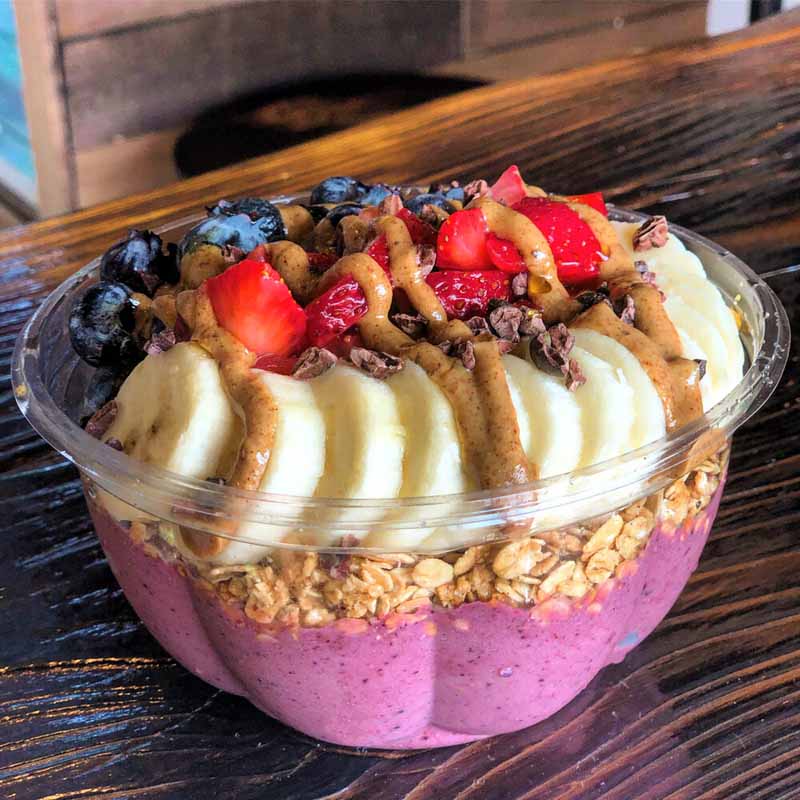
Acai bowls—made from blended frozen Acai fruit with generous, flavorful toppings—have become a popular juice bar staple in recent years. (Source: Thrive Juice Lab)
A well-crafted menu is key to attracting customers and maximizing profits. Your juice recipes should balance taste, cost, and nutrition while catering to current health trends and customer preferences. Testing and refining recipes before launch ensures quality and consistency.
Creating Signature Juice Recipes
Developing unique and flavorful juice combinations helps differentiate your business. Experiment with ingredient ratios to achieve the perfect balance of sweetness, acidity, and freshness. Have friends, family, or focus groups sample your recipes for feedback.
Popular juice ingredients and trends include:
- Celery juice: Known for detoxifying properties.
- Carrot-based juices: Naturally sweet and packed with vitamins.
- Green blends: Spinach, apple, kale, and cucumber for nutrient-dense options.
- Citrus blends: Orange, lemon, and grapefruit for refreshing flavors.
- Exotic fruit blends: Dragon fruit, guava, mango, and passion fruit for tropical appeal.
- Spicy infusions: Ginger, cayenne, or chili peppers for a subtle kick.
- Health-boosting add-ons: Chia seeds, turmeric, medicinal mushroom powders, maca root, collagen, and CBD oil.
Consider expanding your menu with light food options like Acai bowls, yogurt parfaits, salads, and sandwiches to increase average ticket sales. Ensure your kitchen setup meets local health codes for food preparation.
Balancing Cost, Taste, & Nutrition
Balancing cost, taste, and nutrition is essential for a profitable juice bar. Use versatile base ingredients to minimize waste while ensuring a consistent flavor profile. Offset the expense of high-cost superfoods by pairing them with more affordable produce. Additionally, offering customization options allows customers to tailor drinks to their dietary needs while maximizing ingredient efficiency.
Setting Prices for Maximum Profitability
Pricing should reflect ingredient costs, preparation time, and perceived value. Use a cost-plus pricing strategy, ensuring each drink covers expenses and generates a strong profit margin.
- Standard markups: Typically, juices are priced 2.5x to 4x the ingredient cost.
- Bundle deals & upselling: Encourage larger purchases by offering combo deals with snacks or supplements.
- Loyalty programs: Incentivize repeat customers with discounts or free drinks after multiple purchases.
Step 8: Build Your Brand & Online Presence
To successfully open a juice bar business, you will also need a branding strategy and marketing plan. You’ll want to develop a logo, color scheme, and a plan for attracting customers to your business. For most local stores, effective marketing strategies involve a combination of digital and traditional tactics. But the basics include designing a logo, creating a website, and using digital marketing strategies.
Designing a Logo & Store Aesthetic
First, you’ll need to create a logo for your business. Your logo should be distinctive, versatile, and graphic. In other words, it shouldn’t be too text-heavy. Instead, try to come up with a concept or symbol that is a good representative of your juice bar. Keep in mind you will use your logo on your website, on your menus, on to-go cups, on your store signage, and more.
The good news is, you don’t have to be a Photoshop wiz or professional designer to make a logo. There are many cheap (or even free) logo design websites. Popular options include Canva, Looka, and LogoMakr.
Creating a Website & Online Ordering System
Having a website for your juice bar is crucial—primarily because it will help potential customers find and learn about your business when searching on Google.
Creating your own website from scratch is not as complicated as it sounds. There are many easy ways to make a business website for little or no money. You just need a registered domain and a web hosting service. If you plan to offer pickup or delivery, integrate an online ordering system to streamline sales and enhance customer convenience.
Social Media & Influencer Marketing
Social media is a powerful tool for building brand awareness and engaging with customers. Post high-quality images of your juices, share behind-the-scenes content, and run promotions to encourage visits.
Partnering with local influencers or wellness bloggers can boost visibility and attract new customers. Additionally, encourage user-generated content by asking customers to tag your business in their posts, creating organic word-of-mouth marketing.
Step 9: Hire & Train a Great Team
Before opening your juice bar to the public, you’ll need to hire a group of outstanding employees to serve as the front lines of your business. If you haven’t hired an employee before, navigating the process can be really intimidating.
Be sure to go through a new hire checklist that outlines all of the steps you need to take—such as obtaining an Employer Identification Number (EIN), registering for state and local taxes, and so on.
Start the hiring process by writing attractive and compelling job descriptions. Figure out what positions you need to fill (manager, shift supervisor, associate, etc.) and what qualities you are looking for in a candidate Finally, add thorough info about your company and why your future employees will love working there.
Keep in mind that you’ll train your employees on how to prepare your recipes, take care of your store, and provide great customer service—so select candidates with the qualities you can’t train for, like work ethic and enthusiasm.
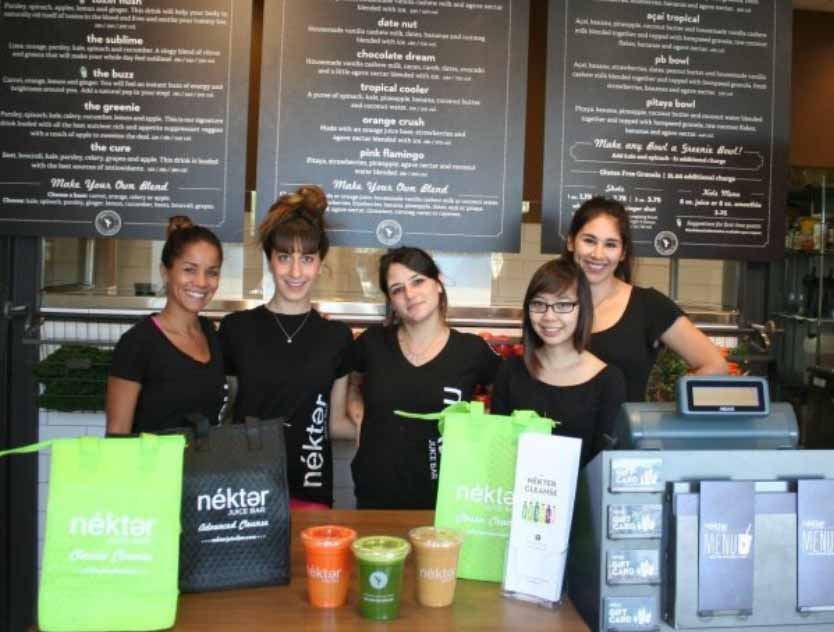
Juice bars typically rely on a small, tight-knit staff to operate, so look for trustworthy employees with relevant experience. (Source: Glassdoor)
Once your staff is hired, it’s important to start training well before you open your juice bar. Practice makes perfect, and skills like juicing and customer service are no different. You want your staff ready to deliver outstanding service to your customers from the minute your store opens. In order to do that, hold a paid training “boot camp” where you practice customer service skills, review recipes, outline expectations, and teach staff about the products and menu items in your store. Find ways to incorporate games and contests to keep the training engaging.
Payroll and HR
Once your staff is hired, you’ll need to handle the HR side of things—including onboarding, payroll, benefits, and performance management.
In lieu of hiring a full HR staff, many small businesses opt to use an HR software or service, like Gusto (shown below). Read our list of the best HR software for small businesses to learn more.
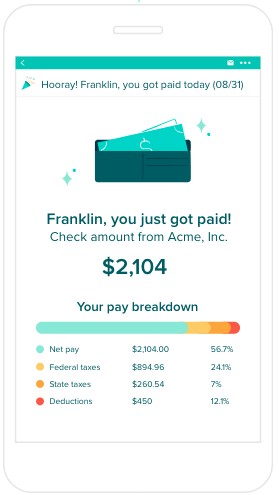
Gusto notifies employees via email every time they receive a direct deposit. (Source: Gusto)
Step 10: Launch & Grow Your Juice Bar
Once your juice bar is ready to open, the next step is generating buzz, building a loyal customer base, and attracting customers through marketing. A successful launch, ongoing promotions, and strong customer engagement will help ensure long-term growth.
Planning a Grand Opening Event
A well-executed grand opening draws attention and attracts customers from the start. Start promoting early by inviting friends and family, creating a Facebook event, and sending press releases to local media. Consider joining your local Chamber of Commerce for additional support—many chambers help promote new businesses, invite local officials, and even secure media coverage.
Running Promotions & Local Marketing
Effective marketing is essential to sustaining customer interest. Use social media to showcase your menu, offer exclusive discounts, and engage with your audience. Run local promotions such as buy-one-get-one deals, referral discounts, or collaborations with nearby businesses. Investing in targeted Facebook or Instagram ads can also increase visibility and bring in new customers.
Managing Customer Reviews & Loyalty Programs
Your online reputation significantly impacts your business. Register your juice bar on Google My Business to appear in search results and Google Maps. Regularly monitor and respond to Yelp and Google reviews to show customers you value their feedback. Additionally, implementing a loyalty program—such as a rewards app or punch cards—encourages repeat visits and builds customer retention.
Bonus: Expert Tips for Success
Once your juice bar is up and running, the next step is scaling your business for long-term growth. Expanding wisely, diversifying revenue streams, and leveraging technology can help you maximize efficiency and profitability.
- Expand Strategically: When opening additional locations, research demand, secure reliable suppliers, and maintain consistency in branding, quality, and service. Start small and scale based on customer demand and operational efficiency.
- Offer Delivery & Subscription Services: Increase revenue by offering delivery through third-party apps or an in-house service. Introduce a subscription model where customers receive fresh juices regularly, ensuring steady sales and customer retention.
- Stay on Top of Trends: Adapt to emerging health trends by incorporating popular ingredients such as adaptogens, gut-health boosters, and functional beverages. Keep your menu fresh and relevant.
- Introduce Juice Cleanses & Prepackaged Options: Offer cleanse programs and grab-and-go juice packs to cater to health-conscious customers looking for convenience and structured nutrition plans.
- Implement a Loyalty Program: Use a digital rewards system to track customer purchases, send promotions, and encourage repeat visits. A well-structured loyalty program drives engagement and long-term retention.
- Adapt to Seasonal Changes: Offer limited-time seasonal juice blends that use fresh, in-season ingredients. This not only enhances quality but also creates excitement and encourages repeat purchases.
Juice Bar Frequently Asked Questions (FAQs)
Click through the sections below to read common questions about opening a juice bar:
A juice bar serves freshly squeezed or freshly pressed juice and smoothies. Juice bars offer both prepared and made-to-order beverages, and often cater to health-conscious consumers.
Fast casual restaurants typically have an average profit margin of 6%–9%. Juice bars tend to earn margins on the higher end of that range (or greater), largely thanks to the simplicity of their offerings.
The average revenue for juice bars ranges from $100,000 to $600,000. Your business could earn more or less depending on location, overhead costs, and customer volume.
Opening a juice bar storefront usually costs anywhere from $20,000–$400,000 on average, but some stores rack up costs of over $1 million. Franchises are typically the most expensive option but can yield greater and faster profits.
Opening a juice bar kiosk or juice bar food truck is significantly less expensive, typically costing $25,000 to $100,000
The factors that contribute to the total cost of opening a juice bar include:
- Location
- Construction/remodeling
- Utilities
- Permits/licenses
- Interior design
- Equipment
- Marketing, branding, and PR
- Contingency funds
A fruit juice shop’s profit margin typically ranges from 10% to 30%, depending on ingredient costs, pricing, and overhead. High markups on fresh juices and add-ons like cleanses or subscriptions can boost profitability. Efficient inventory management also helps maximize margins.
Orange and apple juices are the most popular, while green juices with spinach, kale, and celery are growing in popularity. Citrus blends and tropical flavors like mango and pineapple also sell well, especially in warmer climates. Trends and seasonal demand can influence top-selling options.
Bottom Line
Starting a juice bar requires careful planning, from choosing a business model and securing funding to sourcing high-quality ingredients and marketing effectively. A well-thought-out menu, reliable equipment, and a strong brand presence are key to standing out in a competitive market. Focusing on efficiency, customer engagement, and smart financial management can help you create a profitable and sustainable juice bar business.

